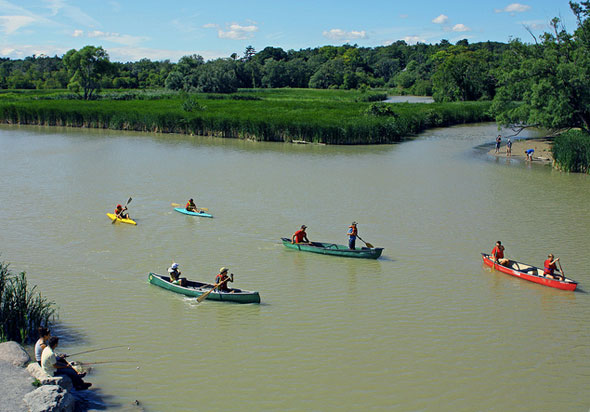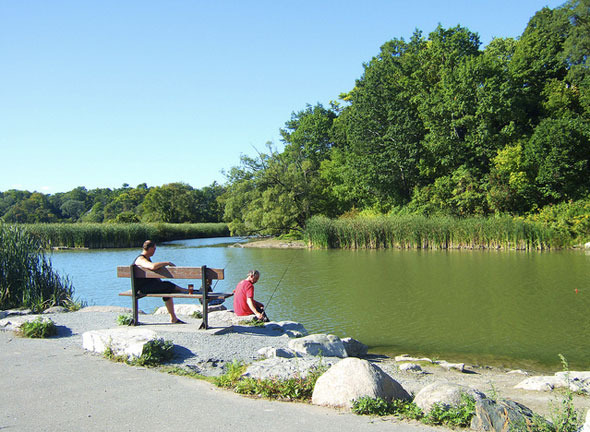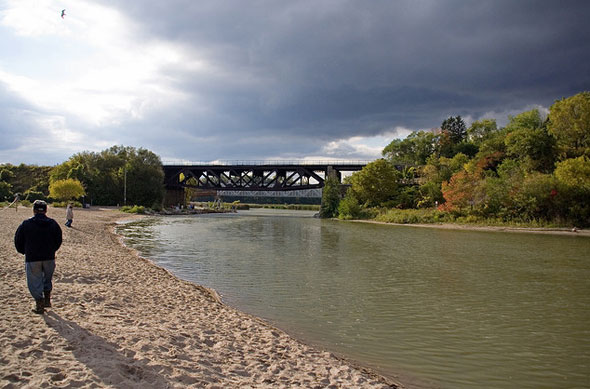
Toronto beaches: Rouge Beach
Rouge Beach is not red. The fine, soft sand that covers most of the beach is pale and white, a gleaming contrast to the deep blue of Lake Ontario and the muddy waters of the nearby Rouge River mouth.
The Rouge River is red, so far as rivers go. French explorers renamed the Rouge in the late 1700s, inspired by the way the river's red clay banks melt into the water as it flows past. Before then, the Rouge was known as "Katabokokonk", an Iroquois word meaning "river of easy entrance."

The beach and the river are part of the Rouge Park system, a 50 square-kilometre park system running from Lake Ontario to the Oak Ridges Moraine. It is the largest urban nature park in North America. The beach, while lovely, is not the main draw - most people who come here come for the river.
There is much to love about the Rouge River valley. It is one of the last rivers in the GTA that rushes from its source in the Moraine down to Lake Ontario, free to swell and fill its floodplain. In 2012, Parks Canada committed $143-million dollars to help the Rouge Park become Canada's first national urban park.
When you approach Rouge Beach, you will see the Rouge Marsh to the north and Lake Ontario to the south. More than half the remaining wetlands in the GTA are right here, in the southern Rouge River. People who love the Rouge will tell you that this is the "best" wetland in the GTA - and there is scientific evidence to back them up. A 2011 study of Durham Region wetlands shows that it is the healthiest wetland in the area, rivalled only by Oshawa's Second Marsh.

There are always people fishing in the area. Fish do spawn in the river and they are edible, provided you stick with the limits outlined in the Guide to Eating Ontario Sportfish. A fishing licence is required, and there are usually paddlers around, too. If you have your own canoe, the mouth of the Rouge is a great place to go - it was called an "easy entrance" for a reason.
It is a bit of a mystery why the water quality at Rouge Beach is not great. Only one other beach in Toronto (Marie Curtis Park Beach) fails water quality tests more frequently. Beaches near the mouths of rivers are usually more contaminated than others because water pollution from hundreds of kilometres upstream washes over them. The bacteria levels upstream on the Rouge River, however, are much lower than bacteria levels at the beach, meaning that the river is not the main culprit.

If you want a day at the beach with the family and guaranteed good swimming, there are other beaches in the city with consistently good water quality. But if you want to enjoy a spectacular river valley, Rouge Beach is a great option. This is the closest to nature you can get without leaving the city boundaries, and water quality is okay on most days (71% of the time) so you may just get to.
THE SKINNY
# of days closed due to water quality problems since June 1 2011: 39
Sand quality: Sandy with some rocks
Trails: Rouge Park trials, Waterfront Trail
Facilities: Washrooms
Travel Info: Parking lot onsite.
By TTC: Take the 54A/E bus to Starspray Blvd
Go Train: Rouge Hill Station is 1.5 km away. Note that the beach is in a residential neighbourhood. It is close enough to walk from transit stops, but there is not a lot of foot traffic.
Seagulls and geese: Pesky in the past, but bird management programs have reduced their numbers
MAP
Krystyn Tully is the co-founder of Lake Ontario Waterkeeper, a Toronto-based charity working for a Lake Ontario in which you can swim, drink, and fish. Check out her Swim Guide smartphone app for more info about beaches in Toronto and beyond.
Photos by Marina Cvet (2), kaeko, ash2276 in the blogTO Flickr pool
Latest Videos
Latest Videos
Join the conversation Load comments







